Bull elk in velvet. Observed in Buchanan County, Virginia. Photo by David Kalb/ DWR.
Elk cows
A bull elk bugling.
Fact File
Scientific Name: Cervus canadensis
Classification: Mammal, Order Artiodactyla, Family Cervidae
Relatives: deer
Conservation Status:
- No special status, although most populations were nearly extirpated in the 19th century due to declines in their distribution and abundance from excessive hunting and habitat loss.
Size: 7–10 feet long from nose to tail and 4.5–5 feet tall at the shoulder; males weigh 700–1,000 lbs and females weigh 400–600 pounds.
Life Span: maximum of 20 years; although less than 10 years is much more typical for wild elk, especially in hunted populations. Females generally live longer than males in all populations.
Identifying Characteristics
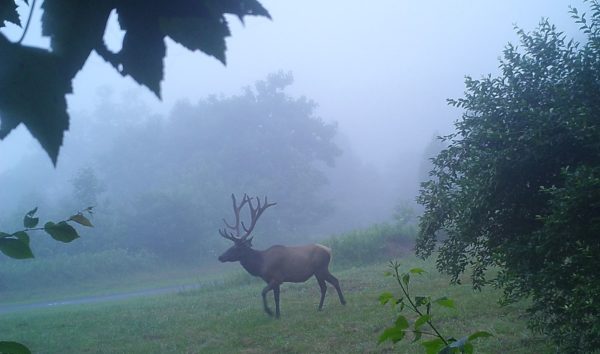
A bull elk, observed in Buchanan County, Virginia. Photo by David Kalb/ DWR.
These large sized, hooved mammals have a long head with large ears, a thick body, short tail, and long slender legs; they are roughly 5 times larger than a white-tailed deer. Elk range in color from dark brown in winter to tan in summer and have a characteristic buff colored rump. They have dark shaggy manes that hang down their neck to their chest. Their back and sides are lighter in color than their head, neck, belly, and legs.
Males, referred to as “bulls,” have widely branching antlers that project backwards off the head and can grow to be nearly 5 feet wide, from tip to tip. Most males are 10% larger than females, referred to as “cows.”
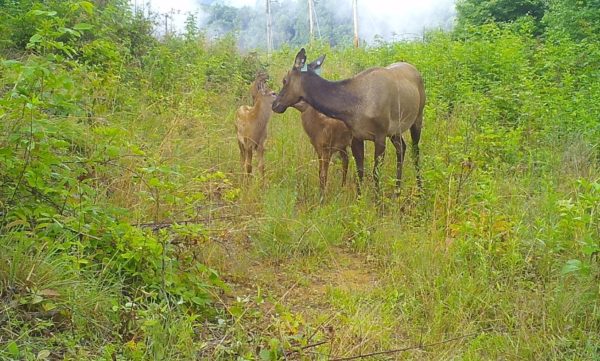
A cow elk (right) with calves (left), observed in Buchanan County, Virginia. Photo by David Kalb/ DWR.
Elk shed their heavy winter coats and antlers in mid to late spring. Male elk lose the velvet on their antlers in late August through early September, just before the fall mating season. Their antlers are shed each year in March and re-grow throughout the following spring and summer. These discarded elk antlers are primarily made of calcium and are quickly consumed by other wildlife species.
Baby elk, called “calves,” have cream colored spots on their backs and sides.
Habitat
Elk occur in a variety of habitats including grasslands, wetlands, shrublands, and forests. They utilize open grassland areas for feeding and densely forested areas to take cover. Virginia’s elk herd prefer open grasslands in early mornings and late evenings and shaded areas during peak daylight hours. Most areas available to elk in Virginia are former surface mines that have been restored to open grasslands.
Diet
Elk are grazers that eat a wide range of vegetation with a preference for the grasses and leafy vegetation of open habitats. When available, elk will also eat acorns and browse woody vegetation.
Distribution:
North America’s remaining elk populations are largely limited to the western U.S. Transplantation efforts, such as that done in Virginia, have created additional small, scattered populations in the central and eastern U.S. In Virginia, elk only occur in the state’s southwest corner on the Cumberland Plateau, representing a minor fraction of their historical range within the Commonwealth. These elk do not migrate like western elk populations due to the prime quality of forage in this area of Virginia (and in neighboring TN, KY, and WV).
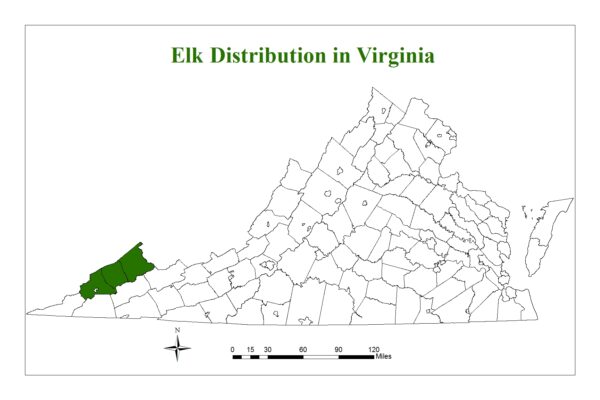
Dominant Males
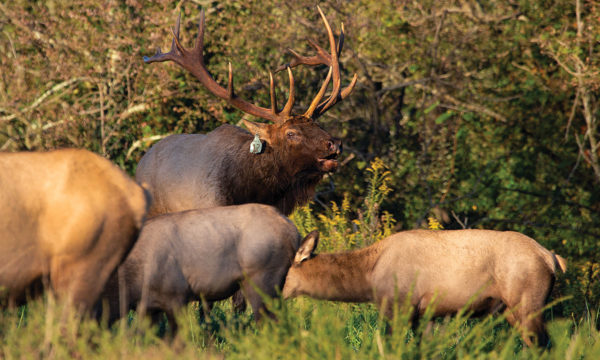
Dominant bull elk (top) with his calves (below), observed in Buchanan County, Virginia. Photo by Lynda Richardson/ DWR.
Elk are polygynous, meaning that the males mate with more than one female at a time. Dominant male elk maintain and defend seasonal harems in the fall, consisting of themselves as the only dominant bull and six to twenty cows with their yearling calves.
During the fall breeding season, known as the “rut,” male elk begin to compete for females. They begin to make loud bugling calls to advertise their territory and status and to attract females. A bull’s bugle is loud enough to be heard a mile away. Bulls of all ages will spar with each other to determine dominance. Fights between dominant males and intruders can become very intense and may result in injury or, very rarely, death.
Protective Females
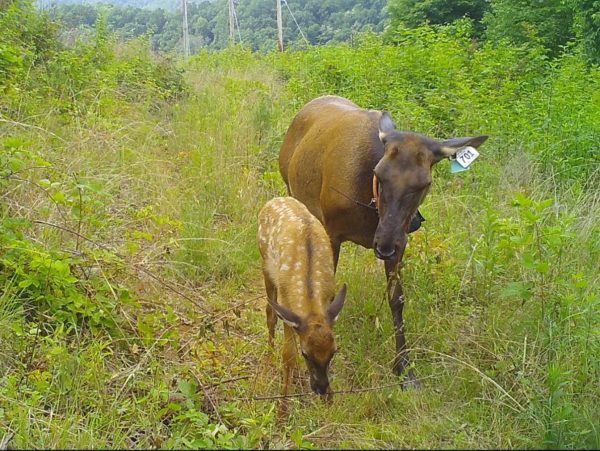
A cow elk (right) and her calf (left) observed in Buchanan County, Virginia. Photo by David Kalb/ DWR.
Cows generally produce a single calve around May after about an eight month gestation period. Only the females care for the young. They are highly protective of their calves and will hide them in a secluded area and live alone with them for a couple of weeks. After a few weeks, the females will lead their calves to join the herd, weaning them within 3 months. However, the females will continue to nurse and protect their young throughout their first year of life.

A cow elk (top) and her calf (below) observed in Buchanan County, Virginia. Photo by David Kalb/ DWR.
Role in the Web of Life
Elk play an important role in shaping the plant communities where they live through their feeding.
In Virginia, the predators of elk include black bears and perhaps coyotes, but they mainly target newborn calves or injured or elderly adults.
Where to See in Virginia
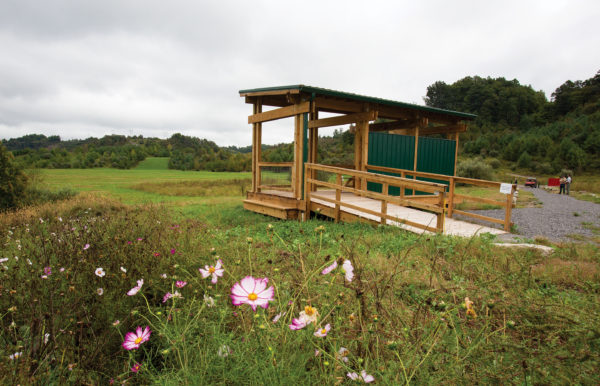
One of three elk viewing stations located within the Elk Viewing Area in Grundy, Virginia on the Virginia Bird & Wildlife Trail.
Virginia’s elk herds can only be found in Southwest Virginia with public viewing opportunities limited to Buchanan County. For the best chance at seeing elk, visit the following sites on the Virginia Bird & Wildlife Trail’s Lonesome Pine Loop in Buchanan County, September through the end of
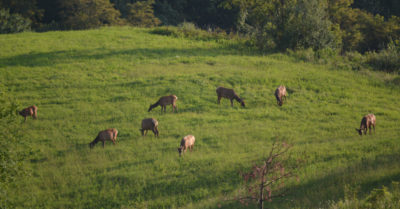
Elk grazing in southwest Virginia.
October. Look for the elk during their peak activity periods at dawn and dusk hours.
- Elk Viewing Area
- elk tours provided by Breaks Interstate Park
- Poplar Gap Park and the Sunset Hollow Area
Can’t make it out to Southwest Virginia to see the elk in person? Watch them live on the DWR’s Elk Cam!
Conservation
The Road to Recovery
Elk were historically found throughout eastern North America, including Virginia. However, by the late 1800s, unsustainable hunting and changes in land use resulted in the extirpation of elk in the eastern portion of the US. The last of Virginia’s elk herd was killed in 1855 in Clarke County.
Between 1913–1916, private land owners as well as the Virginia Department of Wildlife Resources (DWR) attempted the transplantation and reintroduction of elk into 15 Virginia counties. Unfortunately, most of these efforts quickly failed due to a lack of suitable habitat and knowledge of elk ecology. Elk in the Appalachian Mountains held on through the addition of more translocated elk in the 20’s and 30’s, but by 1970, elk once again disappeared from Virginia. Several factors contributed to the elk’s second demise including disease, unsustainable hunting, removal of elk that were eating crops, illegal poaching, and the isolation of small, unsustainable, herds.
From 1997 through 2002, the Kentucky Department of Fish and Wildlife Resources translocated 1,541 elk from six different states and released them in various sites throughout the southeastern portion of the state. Almost immediately, the fast-growing herd began to spill over into Virginia. By the mid-2000’s, with public interest mounting, the Board of the Virginia DWR began to consider the prospect of once again restoring elk to Virginia.
What the DWR Has Done/ Is Doing
To improve the prospects of a successful elk restoration in Virginia, the DWR took a holistic approach with this second attempt. We designated an Elk Management Zone (EMZ) in Southwest Virginia where we worked with partners to create elk habitat and we released the transplanted elk within this EMZ. We also worked with partners to develop a designated elk viewing area and a livestreaming elk cam, and we completed a 10-year Elk Management Plan.
The Restoration
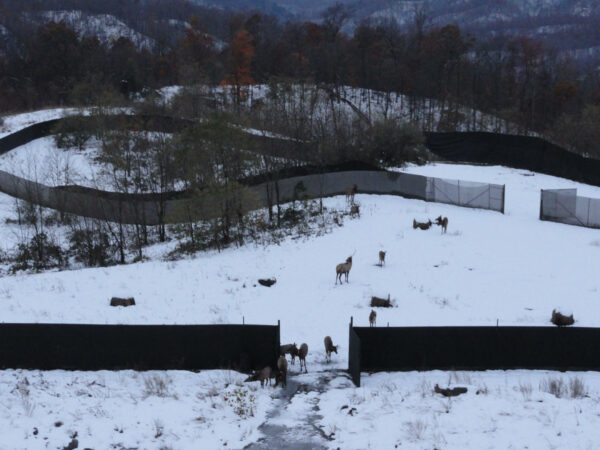
Transplanted elk from Kentucky in a holding pen in Southwest Virginia during their 90-day quarantine period.
Virginia’s EMZ encompasses three counties: Buchanan, Dickenson, and Wise. DWR formed a strong partnership with the local chapter of Rocky Mountain Elk Foundation (RMEF) to create ideal habitat conditions for the elk in this area.
Together, DWR and RMEF funded the restoration of open and well-maintained grassland habitats. Invasive species, such as autumn olive, were removed and the areas have been planted in high quality forage mixes. These improvements have all been implemented by local volunteers.

A bull elk from the first set of elk released in Virginia in 2012. At the time, this was the oldest elk in the herd.
From 2012 through early 2014, DWR released 75 elk within the EMZ.
All funding for this restoration effort came from hunting license sales, RMEF, and the U.S. Fish and Wildlife Service through the Wildlife and Sport Fish Restoration Program from excise taxes on certain sporting goods such as firearms, ammunition, and other hunting gear. Since 2014, the elk population in Virginia has grown, presenting both challenges and opportunities.
Management Planning
DWR contracted Virginia Tech in 2016 to initiate a facilitated public involvement process leading to the development of the Virginia Elk Management Plan.
This 10-year management plan lays out how DWR intends to manage a sustainable population of elk in the EMZ for the benefit of all Virginians.
To help guide our management plan, the agency sought input from a diverse 17 member Stakeholder Advisory Committee (hunters, agricultural and livestock producers, homeowners, forest landowners, animal and ecological health interests, business and tourism industries, motorists, and local, state, and federal agencies), a public survey of stakeholders, and public feedback from broad advertisement of the draft plan.

A cow elk with ear identification tags and a tracking collar, observed in Buchanan County, Virginia. Photo by David Kalb/ DWR.
DWR staff formed an Elk Technical Committee that developed objectives and strategies to attain the goals set forth by the Stakeholder Advisory Committee, while assuring that elk management would be biologically sound and consistent with Virginia Code and regulations. External professional wildlife managers that recently re-established elk populations in eastern states and researchers also provided technical feedback.
On March 21, 2019, the DWR Board of Directors endorsed the Virginia Elk Management Plan.
Learn More About Our Work
- Watch the Elk Cam Live!
- A Year in the Life of a Cow Elk (2020)
- The Reigning King of the Southwest (2019)
- Above the Law: The Roles of CPOs in Elk Territory (2019)
- Elk and Other Wildlife Adventures Await in Southwest Virginia (2018)
- A Growing Elk Herd in Virginia (2016)
How You Can Help
 Purchase a Restore the Wild Membership to support the DWR’s habitat restoration work, such as that accomplished for elk in southwest Virginia. The membership also serves as your pass to visit over 40 DWR Wildlife Management Areas and Lakes throughout the Commonwealth.
Purchase a Restore the Wild Membership to support the DWR’s habitat restoration work, such as that accomplished for elk in southwest Virginia. The membership also serves as your pass to visit over 40 DWR Wildlife Management Areas and Lakes throughout the Commonwealth.- Report and keep your distance from any elk that appear to be sick and/or injured. Report injured or sick elk to the DWR’s Marion Regional Office.
- Walk away quickly from elk calves. Remember elk cows are very protective of their young and can be dangerous to those they perceive as a threat. Do not remain to “make sure the mother returns;” if you are there, she may not return and if she does, she may attack. The mother is likely nearby, deliberately staying out of your sight. Elk cows will leave their young in a secluded location while they feed. This is normal behavior for elk and deer.
- Report to the elk hotline any elk that you either harvest or find dead at 804-367-0044. Calling this number will allow a biologist to collect biological samples. This number is ONLY for making arrangements for tissue sample collection.
Sources
Innes, Robin J. 2011. Cervus elaphus. In: Fire Effects Information System, [Online]. U.S. Department of Agriculture, Forest Service, Rocky Mountain Research Station, Fire Sciences Laboratory (Producer). Accessed August 30, 2019 at http://www.fs.fed.us/database/feis/mammal/ceel/all.html.
Senseman, R. 2002. “Cervus elaphus” (On-line), Animal Diversity Web. Accessed August 16, 2019 at https://animaldiversity.org/accounts/Cervus_elaphus/
Toweill, D. E., and J. W. Thomas. 2002. North American Elk Ecology and Management. Smithsonian Institute Press, Washington DC, USA. 962 pp.
Species Profile Authors: David Kalb, DWR Elk Project Leader, and Jessica Ruthenberg, DWR Watchable Wildlife Biologist
Last updated: January 19, 2024
The Virginia Department of Wildlife Resources Species Profile Database serves as a repository of information for Virginia’s fish and wildlife species. The database is managed and curated by the Wildlife Information and Environmental Services (WIES) program. Species profile data, distribution information, and photography is generated by the Virginia Department of Wildlife Resources, State and Federal agencies, Collection Permittees, and other trusted partners. This product is not suitable for legal, engineering, or surveying use. The Virginia Department of Wildlife Resources does not accept responsibility for any missing data, inaccuracies, or other errors which may exist. In accordance with the terms of service for this product, you agree to this disclaimer.

